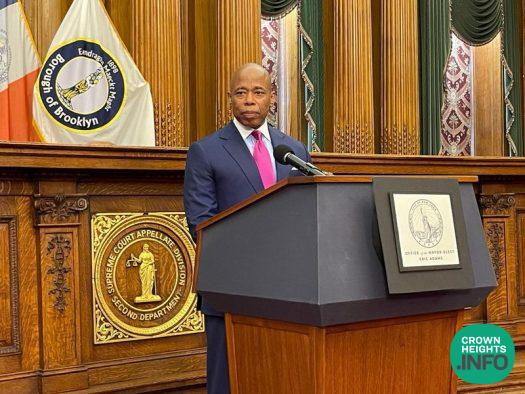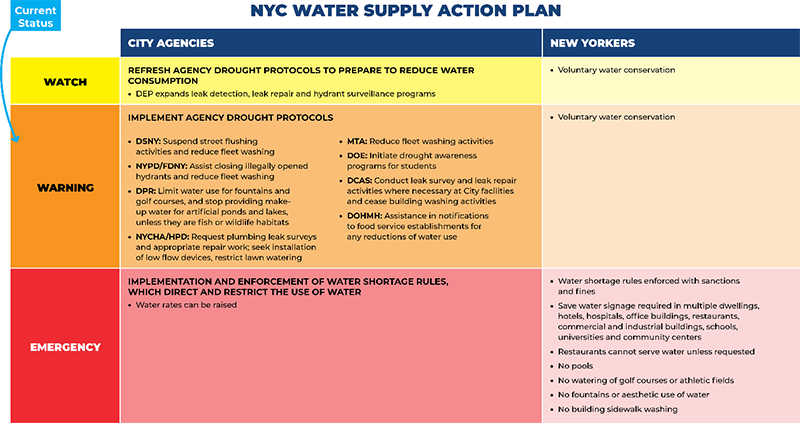
NYC Declares Drought Warning as Lack of Rain and Dry Conditions Persist
New York City Mayor Eric Adams and New York City Department of Environmental Protection (DEP) Commissioner Rohit T. Aggarwala today elevated the citywide drought watch to a drought warning and paused the final phase of DEP’s largest ever infrastructure repair project – the $2 billion Delaware Aqueduct Repair Project – amid a historic and continued precipitation shortage.
As such, Mayor Adams ordered city agencies to implement a range of drought protocols to conserve water and reminded New Yorkers to continue to do their part in saving water wherever possible. Pausing the repair project will allow the city to reopen the aqueduct soon, restarting the flow of water from four additional reservoirs. Conserving water will slow the depletion rate of the stored water in city reservoirs and can potentially postpone or eliminate the threat of a serious shortage. Mayor Adams and Commissioner Aggarwala first issued a drought watch back on November 2.
“As our city and watershed continues to experience significant precipitation shortages, today, I’m upgrading our drought watch to a drought warning, pausing our Delaware Aqueduct repair project, and ordering our agencies to immediately implement water saving measures,” said Mayor Adams. “Our city vehicles may look a bit dirtier, and our subways may look a bit dustier, but it’s what we have to do to delay or stave off a more serious drought emergency. We need New Yorkers to continue to save water too, so we can water our parks and fill our pools this coming summer. New Yorkers always look out for each other. We are resilient and we will get through this together.”
Given the lack of precipitation forecast in the coming weeks, DEP will halt repairs currently underway to the Delaware Aqueduct, an 86-mile pipeline that delivers half of the city’s water supply from the Catskill Mountains. The final phase of the $2 billion repair project, which is DEP’s largest-ever infrastructure project, would have prevented 35 million gallons of drinking water from leaking into the ground in upstate New York every day by connecting a 2.5-mile bypass tunnel near Newburgh, where the leak is occurring. In order to initiate that final phase, the city stopped the flow of water from the four reservoirs that feed into the Delaware Aqueduct. However, the lack of rain upstate has meant that water reserves across all reservoirs are not where they need to be to complete the project in the spring. In the coming days, the city will begin the process of reopening the aqueduct to resume the flow of water from those reservoirs to New York City. DEP will work to restart the project next year to ensure that the Delaware Aqueduct – the world’s longest tunnel of any kind – continues to bring New Yorkers the best drinking water in the world for generations to come.
A drought warning is the second of three levels of water conservation declarations from the city. As conditions evolve, the city may declare a drought emergency, which involves escalating requirements on government agencies and New Yorkers to reduce water usage.

City and state agency water-saving measures include:
- The New York City Department of Sanitation is suspending street flushing activities and reducing vehicle washing.
- The New York City Police Department and Fire Department of the City of New York (FDNY) are assisting in closing illegally opened hydrants and reducing vehicle washing.
- The New York City Department of Parks and Recreation (NYC Parks) is limiting water use for fountains and golf courses and no longer providing make-up water for artificial ponds and lakes unless they are habitats for fish or other wildlife.
- The New York City Housing Authority and New York City Department of Housing Preservation and Development are requesting plumbing leak surveys and appropriate repair work, seeking to install low-flow plumbing fixtures wherever possible and restricting lawn watering.
- New York City Public Schools is initiating water conservation awareness programming for students.
- The New York City Department of City Administrative Services (DCAS) is conducting leak survey and leak repair activities where necessary at city facilities and is no longer washing the exteriors of city buildings.
- The New York City Department of Health and Mental Hygiene (DOHMH) is communicating with food service establishments about reductions of water use.
- The Metropolitan Transportation Authority is reducing fleet washing.
Mayor Adams, today, also reminded all New Yorkers to do their part to conserve water. Some simple tips include:
- Report open fire hydrants and street leaks to 311. An open hydrant can release more than 1,000 gallons per minute, which wastes 1.4 million gallons of drinking water in a 24-hour cycle.
- Don’t flush the toilet unnecessarily. According to the U.S. Environmental Protection Agency (EPA), toilets are by far the main source of water use in a home, accounting for nearly 30 percent of an average home’s indoor water consumption. Each flush can use 1.6 gallons, with older models using as much as 6 gallons.
- Take shorter showers, saving five to seven gallons a minute. When taking a bath, fill the tub only halfway and save 10 to 15 gallons.
- Don’t run the tap while shaving, washing hands, or brushing teeth. Faucets use two to three gallons per minute.
- Fix leaks. A leaky faucet that drips at the rate of one drip per second can waste more than 3,000 gallons per year, according to the EPA.
- Run the dishwasher and washing machine only when full. Use short cycles if available. Turn off the water while washing dishes.
- Install water-saving fixtures, including low-flow toilets and showerheads, as well as faucet aerators.
- Sweep driveways and sidewalks clean rather than washing them down with a hose.
- For even more ideas, visit DEP’s Water Savings Tips website.













